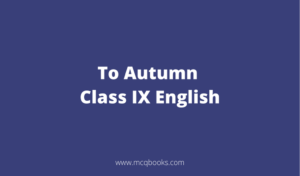To Autumn Poem West Bengal Board Class 9 English
English is a difficult subject for many people to learn. Some students may become frustrated and give up, but here’s To Autumn West Bengal Board Class IX English to help you maintain your momentum! This “To Autumn” poem will provide all necessary information needed in order to study West Bengal Board Class 9 English successfully at home or school; it includes detailed grammar rules with examples that were used during today’s class discussion on the West Bengal Board English Exam.
The “To Autumn” Poem in English, West Bengal Board Class 9 makes it easier to understand the story. Understanding every detail of a story is important for scoring higher on an exam and expert writers have made sure that you know how everything flows together by summarizing perfectly!

Stanza 1
Season of mists and mellow fruitfulness,
Close bosom-friend of the maturing sun;
Conspiring with him how to load and bless
With fruit the vines that round the thatch-eves run;
To bend with apples the moss’d cottage-trees, 5
And fill all fruit with ripeness to the core;
To swell the gourd, and plump the hazel shells
With a sweet kernel; to set budding more,
And still more, later flowers for the bees,
Until they think warm days will never cease, 10
For Summer has o’er-brimm’d their clammy cells.
Stanza 2
Who hath not seen thee oft amid thy store?
Sometimes whoever seeks abroad may find
Thee sitting careless on a granary floor,
Thy hair soft-lifted by the winnowing wind; 15
Or on a half-reap’d furrow sound asleep,
Drows’d with the fume of poppies, while thy hook
Spares the next swath and all its twined flowers:
And sometimes like a gleaner thou dost keep
Steady thy laden head across a brook; 20
Or by a cyder-press, with patient look,
Thou watchest the last oozings hours by hours.
Stanza 3
Where are the songs of Spring? Ay, where are they?
Think not of them, thou hast thy music too,—
While barred clouds bloom the soft-dying day, 25
And touch the stubble plains with rosy hue;
Then in a wailful choir the small gnats mourn
Among the river sallows, borne aloft
Or sinking as the light wind lives or dies;
And full-grown lambs loud bleat from hilly bourn; 30
Hedge-crickets sing; and now with treble soft
The red-breast whistles from a garden-croft;
And gathering swallows twitter in the skies.
Questions And Answers
What is the message of the poem To Autumn by John Keats?
There is a beauty in Autumn’s abundance and fullness and ripeness, and that is something Spring lacks. The message, then, is that we ought to appreciate the beauty of fall and of finding beauty, perhaps, in unexpected places.
What is the main theme of the poem To Autumn?
The main themes in “To Autumn” are the power of nature, the passage of time, and the consolation of beauty. The power of nature: The poem expresses reverence and awe for the great changes wrought by nature as autumn brings its riches to the landscape.
Is To Autumn a love poem?
“To Autumn” is a Romantic poem because it emphasizes an emotional response to an ordinary subject, autumn, and focuses on celebrating nature.
What kind of poem is To Autumn?
The poem is in the form of an ode – highlighting and praising the particular time of year. It is the last of what has come to be known as Keats’ six great odes, all written in the same year (1819). In some of his other, equally famous odes, Keats uses ten lines in each stanza but here he uses one extra line.
Why is autumn called the close bosom-friend of the sun?
The season of mists is called the ‘close bosom-friend’ of the sun as it helps the sun in replenishing nature and ripening of the fruits and growth of vegetables.
What is an ode that explains beauty and death as Keats has described in autumn?
Beauty and Death. As its title would suggest, “To Autumn” celebrates the bountiful beauty of the fall. In the poem, autumn is a season characterized by a rich abundance of life. Often, the poem is taken to be no more than an ode to a lovely, life-filled time of year that is often overshadowed by spring and summer.
What does autumn symbolize in ode to autumn?
In his poem, To Autumn, John Keats expresses the notion that autumn is a time for transformation, yet it still possesses its own beauty that cannot be overlooked. During the Romantic Period, many artists and authors deified nature.